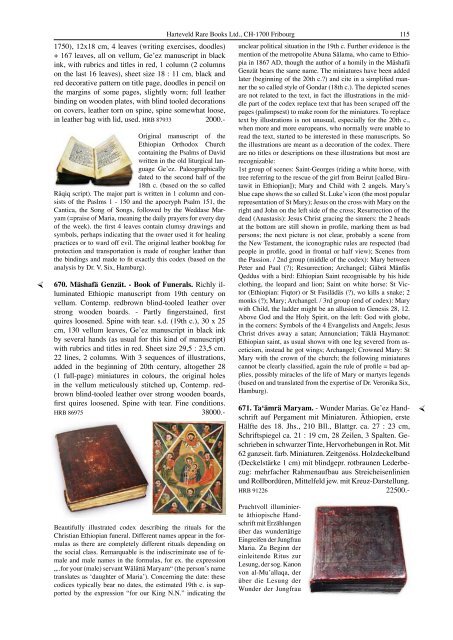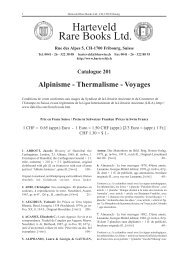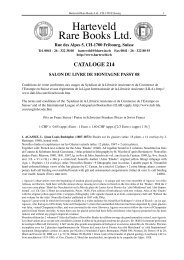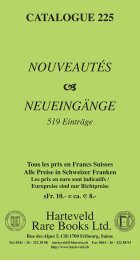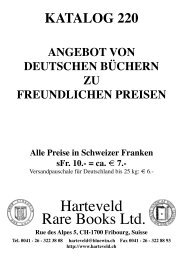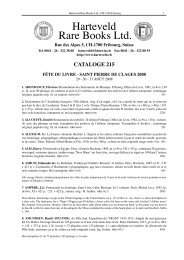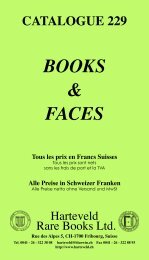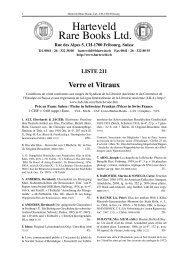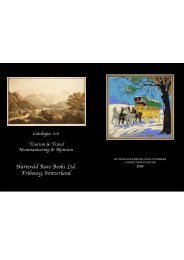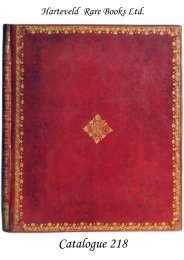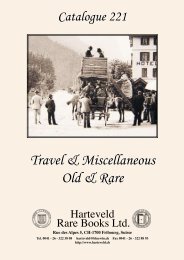Catalogue 217: CHF 20. - Harteveld Rare Books Ltd.
Catalogue 217: CHF 20. - Harteveld Rare Books Ltd.
Catalogue 217: CHF 20. - Harteveld Rare Books Ltd.
You also want an ePaper? Increase the reach of your titles
YUMPU automatically turns print PDFs into web optimized ePapers that Google loves.
�<br />
1750), 12x18 cm, 4 leaves (writing exercises, doodles)<br />
+ 167 leaves, all on vellum, Ge’ez manuscript in black<br />
ink, with rubrics and titles in red, 1 column (2 columns<br />
on the last 16 leaves), sheet size 18 : 11 cm, black and<br />
red decorative pattern on title page, doodles in pencil on<br />
the margins of some pages, slightly worn; full leather<br />
binding on wooden plates, with blind tooled decorations<br />
on covers, leather torn on spine, spine somewhat loose,<br />
in leather bag with lid, used. HRB 87933 2000.-<br />
Original manuscript of the<br />
Ethiopian Orthodox Church<br />
containing the Psalms of David<br />
written in the old liturgical language<br />
Ge’ez. Paleographically<br />
dated to the second half of the<br />
18th c. (based on the so called<br />
Räqiq script). The major part is written in 1 column and consists<br />
of the Paslms 1 - 150 and the apocryph Psalm 151, the<br />
Cantica, the Song of Songs, followed by the Weddase Maryam<br />
(=praise of Maria, meaning the daily prayers for every day<br />
of the week). the first 4 leaves contain clumsy drawings and<br />
symbols, perhaps indicating that the owner used it for healing<br />
practices or to ward off evil. The original leather bookbag for<br />
protection and transportation is made of rougher leather than<br />
the bindings and made to fit exactly this codex (based on the<br />
analysis by Dr. V. Six, Hamburg).<br />
670. Mäshafä Genzät. - Book of Funerals. Richly illuminated<br />
Ethiopic manuscript from 19th century on<br />
vellum. Contemp. redbrown blind-tooled leather over<br />
strong wooden boards. - Partly fingerstained, first<br />
quires loosened. Spine with tear. s.d. (19th c.), 30 x 25<br />
cm, 130 vellum leaves, Ge’ez manuscript in black ink<br />
by several hands (as usual for this kind of manuscript)<br />
with rubrics and titles in red. Sheet size 29,5 : 23,5 cm.<br />
22 lines, 2 columns. With 3 sequences of illustrations,<br />
added in the beginning of 20th century, altogether 28<br />
(1 full-page) miniatures in colours, the original holes<br />
in the vellum meticulously stitched up, Contemp. redbrown<br />
blind-tooled leather over strong wooden boards,<br />
first quires loosened. Spine with tear. Fine conditions.<br />
HRB 86975 38000.-<br />
Beautifully illustrated codex describing the rituals for the<br />
Christian Ethiopian funeral. Different names appear in the formulas<br />
as there are completely different rituals depending on<br />
the social class. Remarquable is the indiscriminate use of female<br />
and male names in the formulas, for ex. the expression<br />
„..for your (male) servant Wälättä Maryam“ (the person’s name<br />
translates as ‘daughter of Maria’). Concerning the date: these<br />
codices typically bear no dates, the estimated 19th c. is supported<br />
by the expression “for our King N.N.” indicating the<br />
<strong>Harteveld</strong> <strong>Rare</strong> <strong>Books</strong> <strong>Ltd</strong>., CH-1700 Fribourg 115<br />
unclear political situation in the 19th c. Further evidence is the<br />
mention of the metropolite Abuna Sälama, who came to Ethiopia<br />
in 1867 AD, though the author of a homily in the Mäshafä<br />
Genzät bears the same name. The miniatures have been added<br />
later (beginning of the 20th c.?) and cite in a simplified manner<br />
the so called style of Gondar (18th c.). The depicted scenes<br />
are not related to the text, in fact the illustrations in the middle<br />
part of the codex replace text that has been scraped off the<br />
pages (palimpsest) to make room for the miniatures. To replace<br />
text by illustrations is not unusual, especially for the 20th c.,<br />
when more and more europeans, who normally were unable to<br />
read the text, started to be interested in these manuscripts. So<br />
the illustrations are meant as a decoration of the codex. There<br />
are no titles or descriptions on these illustrations but most are<br />
recognizable:<br />
1st group of scenes: Saint-Georges (riding a white horse, with<br />
tree referring to the rescue of the girl from Beirut [called Birutawit<br />
in Ethiopian]); Mary and Child with 2 angels. Mary’s<br />
blue cape shows the so called St. Luke’s icon (the most popular<br />
representation of St Mary); Jesus on the cross with Mary on the<br />
right and John on the left side of the cross; Resurrection of the<br />
dead (Anastasis): Jesus Christ gracing the sinners: the 2 heads<br />
at the bottom are still shown in profile, marking them as bad<br />
persons; the next picture is not clear, probably a scene from<br />
the New Testament, the iconographic rules are respected (bad<br />
people in profile, good in frontal or half view); Scenes from<br />
the Passion. / 2nd group (middle of the codex): Mary between<br />
Peter and Paul (?); Resurrection; Archangel; Gäbrä Mänfäs<br />
Qeddus with a bird: Ethiopian Saint recognisable by his hide<br />
clothing, the leopard and lion; Saint on white horse: St Victor<br />
(Ethiopian: Fiqtor) or St Fasilädäs (?), wo kills a snake; 2<br />
monks (?); Mary; Archangel. / 3rd group (end of codex): Mary<br />
with Child, the ladder might be an allusion to Genesis 28, 12.<br />
Above God and the Holy Spirit, on the left: God with globe,<br />
in the corners: Symbols of the 4 Evangelists and Angels; Jesus<br />
Christ drives away a satan; Annunciation; Täklä Haymanot:<br />
Ethiopian saint, as usual shown with one leg severed from asceticism,<br />
instead he got wings; Archangel; Crowned Mary: St<br />
Mary with the crown of the church; the following miniatures<br />
cannot be clearly classified, again the rule of profile = bad applies,<br />
possibly miracles of the life of Mary or martyrs legends<br />
(based on and translated from the expertise of Dr. Veronika Six,<br />
Hamburg).<br />
671. Ta‘ämrä Maryam. - Wunder Marias. Ge’ez Handschrift<br />
auf Pergament mit Miniaturen. Äthiopien, erste<br />
Hälfte des 18. Jhs., 210 Bll., Blattgr. ca. 27 : 23 cm,<br />
Schriftspiegel ca. 21 : 19 cm, 28 Zeilen, 3 Spalten. Geschrieben<br />
in schwarzer Tinte, Hervorhebungen in Rot. Mit<br />
62 ganzseit. farb. Miniaturen. Zeitgenöss. Holzdeckelband<br />
(Deckelstärke 1 cm) mit blindgepr. rotbraunen Lederbezug:<br />
mehrfacher Rahmenaufbau aus Streicheisenlinien<br />
und Rollbordüren, Mittelfeld jew. mit Kreuz-Darstellung.<br />
HRB 91226 22500.-<br />
Prachtvoll illuminierte<br />
äthiopische Handschrift<br />
mit Erzählungen<br />
über das wundertätige<br />
Eingreifen der Jungfrau<br />
Maria. Zu Beginn der<br />
einleitende Ritus zur<br />
Lesung, der sog. Kanon<br />
von al-Mu’allaqa, der<br />
über die Lesung der<br />
Wunder der Jungfrau<br />
�


